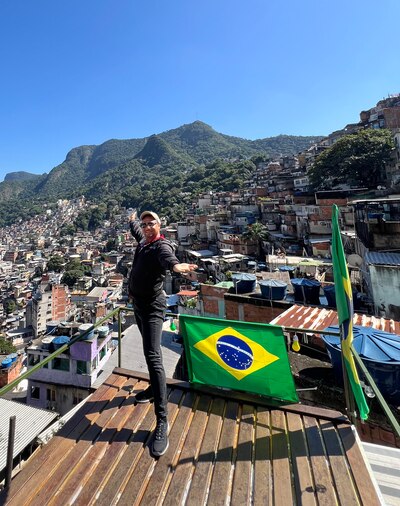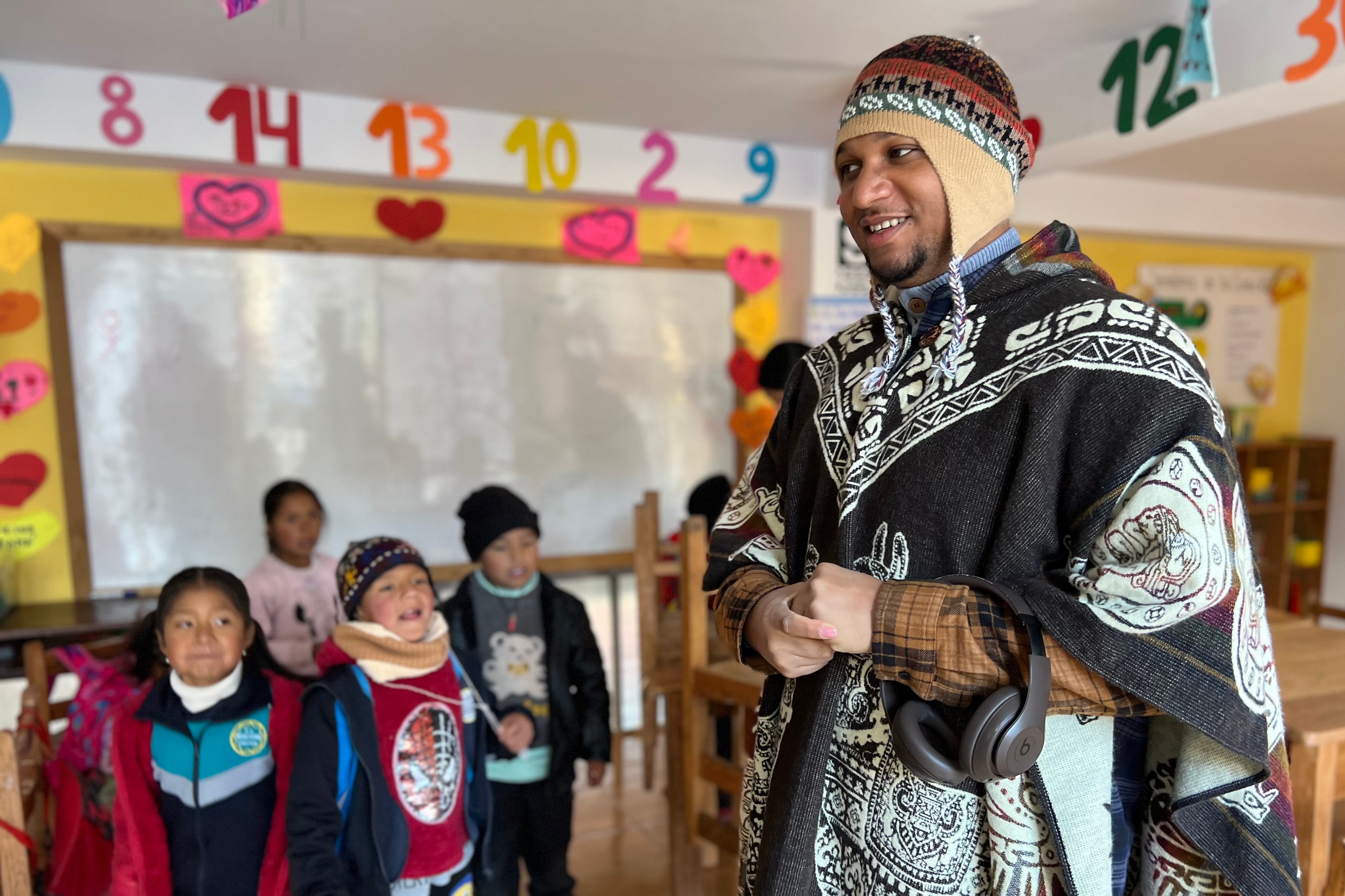Yan Carlos Mejia sees himself in his students.
Mejia, who teaches students learning English as a new language at the Bronx’s Castle Hill Middle School, came to the U.S. from the Dominican Republic when he was 13. He felt frustrated to leave his friends behind and was “scared, speechless, and struggling with English.”
“When I teach, I’m reminded of myself sitting in the corner of the classroom, feeling helpless, trying to blend in, and feeling invisible,” he said. “The only time I felt truly alive back then was when I listened to my teacher read aloud. For a moment, I could lose myself in the characters and their stories, walking through their lives.”
Now, nearly a decade into his career as an English as a New Language teacher, he has made it his mission to bring stories to his students that they can relate to — and he’s found creative ways to do that.
After realizing he was having difficulty making connections between the English Language Arts curriculum and his multilingual learners, he came up with a dream plan. Mejia would visit several of his students’ home countries — Mexico, Peru, Argentina, and Brazil — and gather books and teaching ideas, from folktales to contemporary works by Latin American authors, to create lessons that could more meaningfully connect with his students.
“How can you relate to or understand a character or story if you have no prior knowledge? How can you participate in ‘turn and talk’ if you lack the answers? How can you identify and analyze different types of conflict if you can’t relate to them?” Mejia asked. “I knew I had to do something.”
He was able to put that plan into action this summer when he became one of the 365 teachers from across the country to win a $5,000 grant from the Fund for Teachers. These prestigious summer fellowships fund self-directed travel projects. (Applications are now open for the fund’s summer 2025 grants.)

For example, after visiting the Frida Kahlo Museum in Mexico, he incorporated pictures from his visit into a “do now” classroom activity. He also used videos from Machu Picchu in Peru to create engaging discussion questions.
Across New York City, more than 16% of students are English Language Learners, and many of these students struggle in school. Just 62% of seniors learning English graduated in 2023, compared to the overall citywide graduation rate of 84%.
“Often, we see English language learners as lacking something because they don’t yet know English,” Mejia said. “However, they possess a wealth of knowledge in their first language. As teachers, our job is to provide access to grade-level content while they acquire English.”
This interview has been edited for length and clarity.
How and when did you decide to become a teacher?
I never dreamed of becoming a teacher. In fact, my biggest aspiration was to be a news anchor, specifically for Telemundo. After completing my bachelor’s degree, I worked as a freelance journalist for various Spanish media outlets. However, I quickly realized that I wasn’t happy. I didn’t enjoy writing or creating content just for “views” or “likes.”
I vividly remember discussing my frustrations with a high school teacher of mine, who suggested I apply for the New York City Teaching Fellows program. She remembered my involvement in student government, where I served as vice president, and how active I was in the school community. Now it makes sense why I was labeled “teacher’s pet” in the yearbook!
Out of curiosity, I decided to apply for the program, and the rest is history. The moment I stepped into the classroom during my internship, I fell in love with teaching.
What’s your favorite lesson to teach and why?
In my ICT (integrated co-teaching) transitional bilingual classroom, I love collaborating with my co-teacher to create lessons where students are actively engaged and moving. The goal of this program is to help students who are not proficient in English gradually transition to English-only instruction. We start by providing instruction in their native language while teaching English. As their English proficiency improves, more instruction is given in English, helping them keep up academically while developing language skills.
My co-teacher, who is special education certified, suggested trying parallel teaching. We both instruct at the same time, often dividing content based on students’ needs, and we put a whiteboard in the middle of the room for clarity. For example, one teacher may provide instruction in the students’ native language, while the other focuses on English. At first, I was hesitant because of the noise level — since we do both talk at the same time — but now that we’ve set clear classroom norms, the noise is more manageable. This approach allows us to better target students’ specific needs and provide tailored support, ensuring they remain engaged and productive.
What’s something happening in the community that affects what goes on inside your classroom or your school?
All of my students are immigrants and English language learners. Given the current misinformation about immigrant communities, I use the Courageous Conversation Protocol to initiate discussions and reflect on what’s happening in the world. This helps create a safe space where students feel comfortable sharing their opinions and feelings. I provide them with the opportunity to engage in meaningful dialogue, helping them process and understand the issues that affect their lives.
Can you tell us more about working with multilingual learners, the challenges and the triumphs?
One challenge is that MLLs can be hesitant to participate in class discussions, fearing they might mispronounce words. To support them, I provide wait time, sentence starters, sentence frames, and tiered vocabulary. It’s also important to create opportunities for them to take on leadership roles in the classroom, boosting their self-esteem and helping them realize they have so much to offer — and they truly do.
Tell us about your own experience with school and how it affects your work today.
As an adult, I’m still in contact with my high school and middle school teachers. In fact, they were the ones who wrote my letters of reference for my second master’s and doctoral programs. I often think about one teacher in particular, Ms. Negron. I don’t remember the specific lessons, group work, or sentence starters we used, but I’ll never forget how she made me feel — like I mattered. I remember how she asked us questions and genuinely listened to us.
That’s the kind of teacher I aspire to be: one who makes each student feel important, one who listens, one who asks thoughtful questions. I aim to create a student-led classroom where every voice is heard.
What’s one thing you’ve read that has made you a better educator?
One of the most impactful books I’ve read is “Caste” by Isabel Wilkerson, which was a required reading for my school leadership program. This powerful work opened my eyes to the intricacies of social hierarchies and the deep-seated inequities that exist in our society. It challenged me to reflect on how systemic issues influence my students’ lives and learning experiences.
By understanding the concept of caste, I’ve become more aware of the barriers my students face and the importance of advocating for equity in the classroom. This awareness has prompted me to create more inclusive and supportive learning environments where all students feel valued and have the opportunity to thrive.
Amy Zimmer is the bureau chief for Chalkbeat New York. Contact Amy at azimmer@chalkbeat.org.







